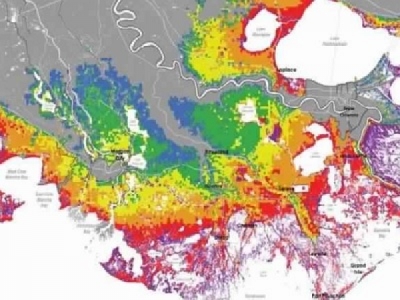
Posted on September 26, 2018
State officials are soliciting public input for the next update of Louisiana’s $50 billion, 50-year coastal master plan.
The plan, last updated in 2017, includes projects and programs aimed at fighting coastal erosion, rising seas, sinking land and hurricanes — all of which threaten to inundate coastal communities like Terrebonne and Lafourche.
The state Coastal Protection and Restoration Authority is accepting project ideas from residents, governments, researchers, organizations and anyone with ideas for the plan it will submit to the state Legislature in 2023.
“Predictions in the 2017 Coastal Master Plan of future coastal land loss and storm surge-based flood risk, even with plan implementation, demonstrate that isolated project investments often provide minimal benefits beyond their immediate footprint or local area,” the authority says in a news release. “Future predictions show the scale of the challenge facing coastal Louisiana and reinforce the need for the master plan process to focus on investments with beneficial effects at the sub-basin to regional scale.”
The agency says it will accept proposals for the next plan that “meet this challenge.”
“CPRA is eager to review new project proposals,” Executive Director Michael Ellison said.
He said the agency is particularly interested in projects that:
Continue to provide benefits in the face of sea level rise and sinking land without continued maintenance.
Contribute to maintaining wetlands for future decades.
Reduce storm surges at the community or regional scale.
Email proposals, in PDF format, to MasterPlan@la.gov, or mail printed copies to the 2023 Coastal Master Plan Project Development Program at P.O. Box 44027, Baton Rouge, LA, 70804. Deadline to submit ideas is March 1.
Why it matters to you
Highlights from the state’s coastal master plan for Terrebonne and Lafourche:
The most optimistic projections put the Gulf of Mexico up against south Lafourche’s ring levee and Terrebonne’s Morganza levees within 50 years, raising questions about the systems’ ability to protect against flooding or withstand hurricanes. The worst-case scenario shows the levee systems could be overtopped by normal tides and significantly compromised by storm surges.
The plan calls for the state to spend $1.5 billion to restore barrier islands, including those off the two parishes’ coast. But even after the work, rising seas and persistent erosion will cause the islands to wither almost to their current state, slivers of sand that offer little protection against storms.
For the first time, the state estimates the number of local homes whose owners would be offered unspecified financial aid aimed at making the buildings more resistant to flooding. Homes threatened by such severe flooding would be offered voluntary buyouts to move to higher ground. Combined, more than 8,200 homes and businesses would qualify for the various programs in Terrebonne and Lafourche.
The two parishes, which have suffered some of the state’s greatest losses of coastal wetlands over the years, would also receive some of the most-expensive projects, totaling $14.8 billion combined. The biggest would spend $8.3 billion to upgrade the 98-mile Morganza-to-the-Gulf hurricane-protection system. Congress has repeatedly rebuffed local requests for the money, and the state plan, as with most projects, does not specify where it would come from.
Email questions to MasterPlan@la.gov with “2023 Coastal Master Plan Project Development” in the subject line.
For detailed project guidelines, or more on the master plan, visit coastal.la.gov or call the authority at (225) 342-7308.
Gov. John Bel Edwards plans to convene representatives from various state agencies to enhance coordination of Louisiana’s fight to protect coastal residents from flooding.
“We’ll work to identify new ways to adapt and build resilience across agencies and departments and across the coast as a whole,” Camille Manning-Broome, president and CEO of the Center for Planning Excellence, said in a news release.
The Baton Rouge-based nonprofit is helping to organize the forum.
“Building resilience encompasses a broader range of solutions, expertise and funding than can be addressed by CPRA and the flood-risk-reduction and environmental-restoration projects in the coastal master plan alone,” said Charles Sutcliffe, director of policy and programs for the Governor’s Office of Coastal Activities.
Source: houmatoday.com





